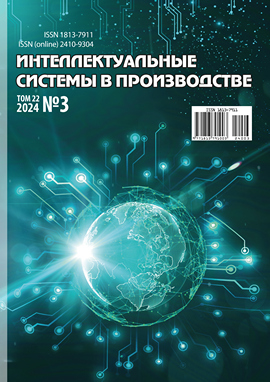The Model of the Armament And Military Equipment Repair System
DOI:
https://doi.org/10.22213/2410-9304-2024-3-97-102Keywords:
repair, production capability, intensity, repair and restoration bodies, restoration, armament and military equipmentAbstract
The purpose of the study, the results of which are presented in the article, is to develop a mathematical model of the process of restoring weapons and military equipment (IWT), taking into account their losses due to combat and operational and technical reasons, as well as the production capabilities of repair and restoration bodies (RVOS) of the first and second levels. For the operational solution of the recovery system planning and managing tasks, it is necessary to have models that allow approximate assessment of the system effectiveness at various levels of management. The hypothesis of the study is to increase the efficiency of restoring weapons and military equipment using the forces and means of military repair bodies, field repair brigades (VRB) in the conditions of the operation, as well as the production capacities of enterprises of the local industrial economic base. As criteria for effectiveness evaluation, the indicators characterizing the combat capabilities of military formations for a certain period of military planning in peacetime and wartime are considered. Research methods are mathematical apparatus of the theory of queuing systems and differential equations of "dynamics of averages", system analysis, comparative analysis, generalization, forecasting, and document analysis. The resulting model establishes a relationship between the input parameters and the output indicators of the recovery system, characterizing the serviceability of the IWT. In this case, the control parameter is a parameter that characterizes the ratio of the number of samples of military equipment repaired in the 1st-level RVR. Results: the developed model can be used for: analyzing the technical support system of troops; solving optimization problems of managing the technical support of troops: finding the optimal ratio of the number of samples of military equipment repaired by the first and second level RVOS; determining the optimal number of field crews for repairing military equipment while ensuring a given level of serviceability of military equipment and minimizing the cost of repairing military equipment.References
Михайлов А. Л., Цапок А. В. Методика расчета интенсивности восполнения вооружения и военной техники в операции // Глобальный научный потенциал. 2020. № 4 (109). С. 200-203.
Сидоренко К. П., Руссу А. Б. Модель оценки эффективности функционирования системы материально-технического обеспечения Сил ВМФ // Морская радиоэлектроника. 2011. № 4 (38).
Горевич Б. Н. Методический подход к оценке эффективности обороны объектов (на примере ПВО) // Военная мысль.- 2009. № 1.
Буравлев А. И., Еланцев Г. А. Вероятностные модели управления жизненным циклом вооружения и военной техники // Вооружение и экономика. 2021. № 3 (57). С. 45-65.
Филяев М. П., Воробьев А. А. Актуальные вопросы имитационно-аналитического моделирования логистических процессов ракетно-технического обеспечения // Восьмые Уткинские чтения: труды Общероссийской научно-технической конференции. Сер. "Библиотека журнала "Военмех. Вестник БГТУ". 2019. С. 290-296.
Ломовцева П. Е. Сравнительный анализ методов статистического и имитационного моделирования процессов материально-технического обеспечения // Научные проблемы материально-технического обеспечения Вооруженных сил Российской Федерации: сборник научных трудов / под ред. А. А. Целыковских, вып. 2 (16). СПб.: Издательство НИИ (ВСИ МТО ВС РФ) ВА МТО, 2020. С. 21-29.
Буравлев А. И., Белозоров М. С. Модель управления технической готовностью ВВСТ при планировании и реализации государственной программы вооружения // Вооружение и экономика. 2022. № 1 (59). C. 12-32.
Буренок В. М. Современные мировые тенденции развития и применения систем материально-технического обеспечения действий войск // Вооружение и экономика. 2022. № 2 (60). C. 7-11.
Тришункин В. В., Бычков А. В., Мурманских И. В. Реализация опыта материально-технического обеспечения на удаленном театре военных действий Войск (Коллективных сил) Организации Договора о коллективной безопасности // Военная мысль. 2021. № 2. С. 43-54.
Давлетов Б. Х. Особенности организации ремонта военной техники в современных условиях // Бюллетень науки и практики. 2022. Т. 8, № 4. С. 418-425.
Маев С. А. Под знаменем ремонта // Военно-промышленный курьер. 2016. № 37 (652).
Савельев К. А. Исторический опыт и значение технического обслуживания и ремонта вооружения и военной техники в ходе боевых действий. Перспективы развития средств технического обслуживания и ремонта подразделений технического обеспечения // Синергия наук. 2020. № 53. С. 553-571.
Буравлев А. И. Военно-экономические и военно-технические аспекты оценки боевых возможностей группировок войск в задачах программно-целевого планирования // Вооружение и экономика. 2020. № 3 (53).
Серба В. Я., Грачев В. В. Проблемы и направления совершенствования системы материально-технического обеспечения Вооруженных сил Российской Федерации // Военная мысль. 2018. № 5. С. 37-42.
Булгаков Д. В. Актуальные вопросы материально-технического обеспечения войск (сил) // Актуальные проблемы защиты и безопасности: Труды XXII Всероссийской научно-практической конференции РАРАН (1-4 апреля 2019 г.). Т. 6. СПб.: Российская академия ракетных и артиллерийских наук, 2019. 248 с.
Downloads
Published
How to Cite
Issue
Section
License
Copyright (c) 2024 Антон Владимирович Цапок

This work is licensed under a Creative Commons Attribution 4.0 International License.


